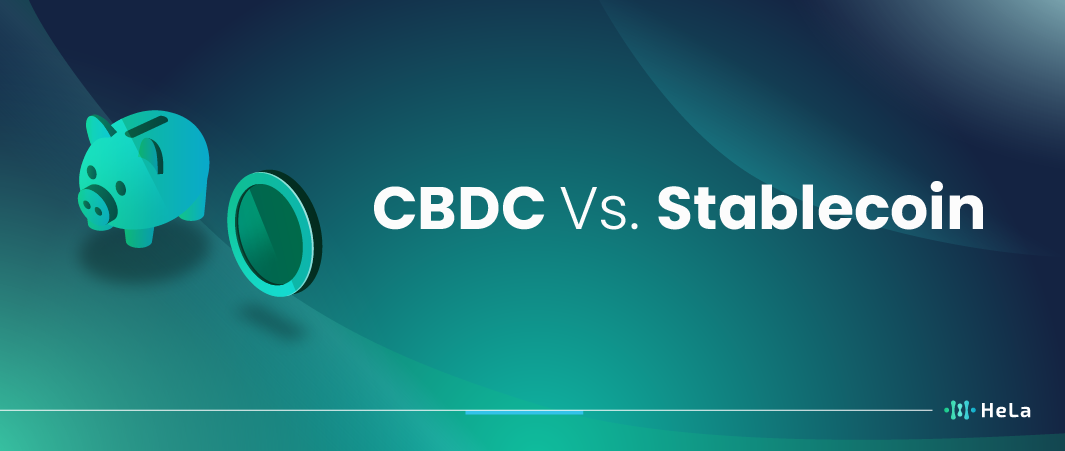In the evolving landscape of digital currencies, two terms have increasingly dominated discussions: CBDC (Central Bank Digital Currency) and Stablecoin. Both represent innovative strides in electronic money, albeit from different angles and motivations. As these digital currencies gain traction, it’s crucial for anyone involved in the finance or technology sectors to grasp their fundamental differences and potential implications.
CBDCs are digital currencies issued by central banks, representing a nation’s official currency in a digital form. They’ve garnered attention as governments globally consider modernizing their monetary systems, especially in an increasingly cashless society. On the other hand, Stablecoins, mostly associated with the decentralized world of cryptocurrencies, aim to offer stability, pegging their value to a reserve of assets.
Diving deeper, this article will shed light on the key features of CBDCs and Stablecoins, and how they stand in comparison to one another. Join us as we journey through their foundational attributes, applications, advantages, and challenges.
CBDC: The Digital Extension of National Currencies

Central Bank Digital Currencies (CBDCs) are like the online version of your country’s money, regulated by the central bank. You can think of them as digital cash that holds the same value and legal status as the paper bills you’re used to. They’re a way for governments to adapt to the digital age and make it easier for people to do transactions and access financial services online.
Unlike cryptocurrencies like Bitcoin, CBDCs are managed by the government and don’t rely on complicated technology. Instead, they’re a more straightforward way to use your national currency in the digital world. They could make it easier for more people to use digital banking services and speed up transactions, all while making it harder for bad actors to do illegal stuff with money.
Different countries are at different stages in adopting CBDCs, but they represent a pretty big change in how we use money and technology. They could help more people get access to digital banking, speed up how we pay for things, and even make our financial systems more transparent and secure.
Design and Distribution
Central Bank Digital Currencies (CBDCs) can come in two main flavors: “retail,” which is for regular folks like you and me, and “wholesale,” meant for financial institutions to use behind the scenes. When it comes to getting these digital currencies into people’s hands, there are a couple of ways to go about it. The central bank could distribute them directly to the public, or they might work with commercial banks and other middlemen to make it happen. It’s kind of like choosing between buying groceries at a store or having them delivered to your door.
Monetary Policy Influence
When central banks introduce Central Bank Digital Currencies (CBDCs), it’s like giving them a fresh way to manage the economy. They can tinker with how many digital coins they create and how they look, kind of like adjusting the heat on a thermostat. By doing this, central banks can have a say in things like how much interest you pay on loans and other big economic stuff. It’s like they’re steering the ship to help reach their financial goals.
Security and Oversight
Central Bank Digital Currencies (CBDCs) are like having a trusty guardian for your money. The central bank makes sure they’re super safe and hard to mess with. Plus, they give the authorities a way to keep an eye on transactions to make sure everything’s on the up and up, like making sure nobody’s up to no good. It’s kind of like having a security camera in a store to prevent any funny business.
Also Read: What Is Asset Tokenization? Converting Real Assets into Digital Assets for Beginners
Stablecoin: Bridging Traditional Finance and Cryptocurrencies

Stablecoins play a crucial role in connecting the world of traditional finance with the ever-evolving realm of cryptocurrencies. Unlike Bitcoin or Ethereum, which can experience significant price fluctuations, stablecoins offer a more stable value by pegging themselves to assets like the US Dollar or even gold. This stability makes them a reliable option for those looking to engage with digital currencies without the rollercoaster ride of price swings.
One of the main advantages of stablecoins is their ability to serve as a bridge between the old and the new. They provide a familiar anchor in the form of traditional assets, making it easier for people and businesses to navigate the cryptocurrency space. This stability also makes them a practical choice for everyday transactions, offering a degree of predictability often missing in the world of cryptocurrencies.
Furthermore, stablecoins are gaining popularity in the world of decentralized finance (DeFi), where they are used for lending, borrowing, and yield farming. Their consistent value makes them a go-to choice for DeFi enthusiasts, who can enjoy the benefits of blockchain technology without the turbulence typically associated with digital assets. In this way, stablecoins are becoming a pivotal part of the broader financial ecosystem, facilitating a smoother transition from the old to the new in the ever-changing landscape of finance.
Asset-backed Nature
Stablecoins get their steadiness from having a pile of assets behind them. The most usual kind is the one tied to regular money, like the US dollar. But there are also stablecoins linked to stuff like gold, different cryptocurrencies, or a combination of things. This setup keeps them from jumping around in value, making them more reliable for everyday transactions.
Decentralized vs. Centralized
Stablecoins come in two flavors: decentralized and centralized. Decentralized stablecoins run on blockchain platforms, offering users more control and privacy in their transactions. On the flip side, centralized stablecoins are managed by a central authority or company, which usually means they have better liquidity and are subject to regulations. Decentralized versions give users more independence, as they aren’t reliant on a single entity, but centralized options can offer a sense of security and trust, thanks to oversight and governance by a central organization.
Utility in the Crypto Ecosystem
Stablecoins are like the steady anchors in the wild sea of cryptocurrencies. They serve a crucial role in the crypto world by providing a reliable medium for trading, a consistent way to measure value, and a safe place to store your digital assets. Unlike many other cryptocurrencies that can swing wildly in value, stablecoins aim to keep things stable, making them a trusted choice for traders and investors looking for a bit of predictability in the ever-changing crypto market.
Key Distinctions Between CBDC and Stablecoin

Central Bank Digital Currencies (CBDCs) and stablecoins are indeed digital currencies, but they have distinct characteristics and are often created with different purposes in mind. Here are some key distinctions between the two:
Issuing Authority
- CBDCs: Central Bank Digital Currencies are issued and regulated by central banks, which are typically government-controlled entities responsible for a country’s monetary policy. CBDCs are considered legal tender and are backed by the full faith and credit of the government.
- Stablecoins: Stablecoins are typically issued by private companies or entities, not central banks. They are often backed by reserves of fiat currency, cryptocurrencies, or other assets to maintain a stable value.
Regulatory Framework
- CBDCs: CBDCs operate within a well-defined legal and regulatory framework established by the central bank and government. They are subject to strict oversight and compliance with national monetary policies.
- Stablecoins: Stablecoins often operate in a regulatory gray area, as they are not always subject to the same level of scrutiny as traditional financial institutions. Regulatory approaches to stablecoins vary by jurisdiction.
Purpose
- CBDCs: The primary purpose of CBDCs is to provide a digital representation of the national currency. They are often designed to enhance the efficiency of payment systems, reduce transaction costs, and increase financial inclusion. They are also used to maintain control over the money supply.
- Stablecoins: Stablecoins are typically designed with a focus on stability and ease of use in digital transactions. They are often used as a medium of exchange, a store of value, and for cross-border remittances.
Value Stability
- CBDCs: CBDCs are generally designed to maintain a stable value, just like the traditional fiat currency they represent. Their value is not expected to fluctuate significantly.
- Stablecoins: Stablecoins aim to maintain a stable value by pegging their value to another asset, such as a fiat currency like the US dollar, a basket of assets, or even through algorithmic mechanisms. However, their value can fluctuate depending on market dynamics and the effectiveness of their stabilization mechanisms.
Implications for Monetary Policy
- CBDCs: The introduction of CBDCs can have significant implications for a country’s monetary policy, as it may affect money supply, interest rates, and the central bank’s ability to implement traditional tools like open market operations.
- Stablecoins: Stablecoins do not have direct implications for monetary policy, as they are not issued by central banks. However, they can still influence the financial system, especially if they gain widespread adoption and become a significant part of the economy.
Trust and Security
- CBDCs: CBDCs are backed by the government, which can instill a high level of trust in their stability and security. They are often seen as a risk-free digital alternative to physical cash.
- Stablecoins: The stability and security of stablecoins depend on the issuing entity and the assets backing them. Trust in stablecoins may vary, and they are subject to issuer risk.
While both CBDCs and stablecoins are digital currencies, they differ in terms of their issuing authority, regulatory framework, purpose, value stability, implications for monetary policy, and trust and security. The choice between using one or the other can depend on various factors, including the specific goals of a central bank or private entity and the regulatory environment in a given jurisdiction.
Also Read: What Is Stack Mobile? A Step-by-Step Introduction
Potential Use Cases: From Trade to Remittances
Both Central Bank Digital Currencies (CBDCs) and Stablecoins offer unique applications in the modern financial landscape. These digital currencies have the potential to revolutionize various aspects of the financial industry, creating more efficient and inclusive systems.
Cross-Border Trade Facilitation
CBDCs and Stablecoins can streamline cross-border trade by reducing the complexities and costs associated with international transactions. Businesses can use these digital currencies for secure, instant, and low-cost settlements, eliminating the need for intermediaries and reducing currency exchange risks.
Remittances and Financial Inclusion
One of the most promising use cases for CBDCs and Stablecoins is in the field of remittances. Migrants and expatriates can send money back home with lower fees and faster transaction times, making it easier for families to access funds. This can significantly contribute to financial inclusion by providing access to digital financial services for unbanked or underbanked populations.
E-commerce and Online Payments
CBDCs and Stablecoins can enhance online shopping and digital payment experiences. E-commerce platforms can integrate these digital currencies, providing users with faster and more secure payment options. This can reduce the risk of fraud and make online transactions more efficient.
Micropayments and Internet of Things (IoT)
These digital currencies are suitable for handling micropayments, which are essential for services like pay-per-use content or IoT devices that need to conduct small transactions autonomously. The low transaction costs and high speed of CBDCs and Stablecoins make them ideal for these applications.
Financial Services Innovation
CBDCs can serve as the foundation for new financial services and products, such as programmable money, smart contracts, and decentralized finance (DeFi) applications. Stablecoins can be used as collateral in DeFi platforms, enabling users to earn interest, borrow, or trade without relying on traditional banking services.
Monetary Policy Implementation
CBDCs allow central banks to have more direct control over the money supply and monetary policy. They can implement negative interest rates, distribute stimulus payments efficiently, and respond to economic crises more effectively.
Digital Identity and KYC (Know Your Customer) Compliance:
CBDCs and Stablecoins can be linked to digital identity systems, which can improve KYC processes and reduce the risk of fraud and money laundering. This can enhance the overall security and compliance in the financial industry.
Tokenization of Assets
Both CBDCs and Stablecoins can facilitate the tokenization of real-world assets, such as real estate, stocks, and commodities. This can make it easier for investors to access a diverse range of assets and create more efficient markets.
The potential use cases of CBDCs and Stablecoins continue to evolve as technology and regulatory frameworks adapt to their integration. These digital currencies have the capacity to reshape the way we conduct financial transactions, expanding access to financial services, and improving the efficiency of global trade and remittances.
Looking Ahead: The Future of Digital Currencies
The rise of digital currencies, be it Central Bank Digital Currencies (CBDCs) or Stablecoins, underscores a broader shift towards digitization in the financial sector. This transformation is driven by various factors, including the increasing demand for faster and more efficient payment methods, the need for financial inclusion, and the growing influence of blockchain technology.
Hybrid Models
We might see hybrid models in the future that combine features from both CBDCs and Stablecoins, aiming for optimal stability, utility, and security. These hybrid models could offer the best of both worlds by combining the stability and government backing of CBDCs with the innovation and flexibility of Stablecoins. This could be achieved through partnerships between governments and private companies or through collaborative efforts between multiple stakeholders.
Global Collaboration
As digital currencies become more prevalent, global regulatory collaboration will be vital to address challenges and ensure seamless integration. The borderless nature of digital currencies makes it crucial for international regulators to work together to establish common standards, protocols, and regulations. This collaboration is essential to prevent money laundering, fraud, and other illicit activities while also fostering trust and interoperability on a global scale.
Innovation and Evolution
The digital currency landscape is still in its infancy, with ample room for innovation. The coming years will witness evolving models, technologies, and applications. Innovations may include enhanced privacy features, improved scalability, and the development of new use cases beyond simple payments. Furthermore, as blockchain technology advances, it may lead to the integration of smart contracts and decentralized finance (DeFi) applications into the digital currency ecosystem. These advancements will continue to reshape the financial sector and provide new opportunities for individuals and businesses.
Conclusion
As we stand on the cusp of a financial revolution, CBDCs and Stablecoins represent two compelling avenues of digital currency evolution. While they emanate from different origins and serve varied purposes, their core essence is to offer a modern, efficient, and more inclusive monetary system.
The journey of digital currency adoption will undoubtedly be fraught with challenges, from technological hurdles to regulatory complexities. However, the potential benefits—increased efficiency, reduced costs, financial inclusivity, and global economic interconnectivity—make this journey worth undertaking.
In the end, whether one champions CBDCs, Stablecoins, or a potential hybrid, it’s clear that the future of finance will be digitally-driven, demanding adaptability, collaboration, and innovation from all stakeholders.
Disclaimer: The information provided by HeLa Labs in this article is intended for general informational purposes and does not reflect the company’s opinion. It is not intended as investment advice or recommendations. Readers are strongly advised to conduct their own thorough research and consult with a qualified financial advisor before making any financial decisions.

Joshua Soriano
I am a writer specializing in decentralized systems, digital assets, and Web3 innovation. I develop research-driven explainers, case studies, and thought leadership that connect blockchain infrastructure, smart contract design, and tokenization models to real-world outcomes.
My work focuses on translating complex technical concepts into clear, actionable narratives for builders, businesses, and investors, highlighting transparency, security, and operational efficiency. Each piece blends primary-source research, protocol documentation, and practitioner insights to surface what matters for adoption and risk reduction, helping teams make informed decisions with precise, accessible content.
- Joshua Soriano#molongui-disabled-link
- Joshua Soriano#molongui-disabled-link
- Joshua Soriano#molongui-disabled-link
- Joshua Soriano#molongui-disabled-link

